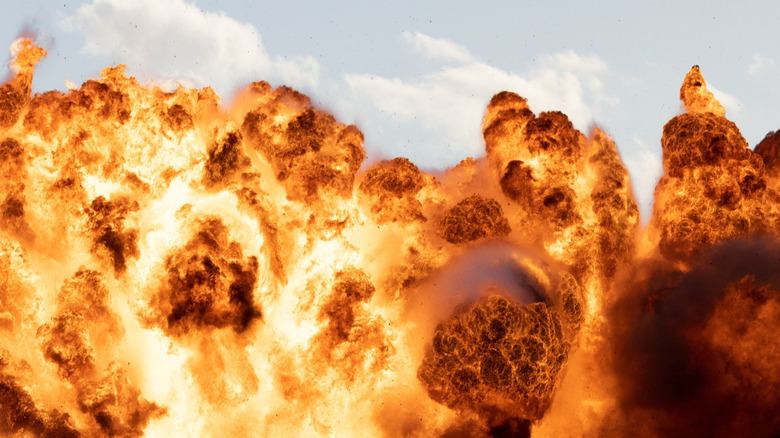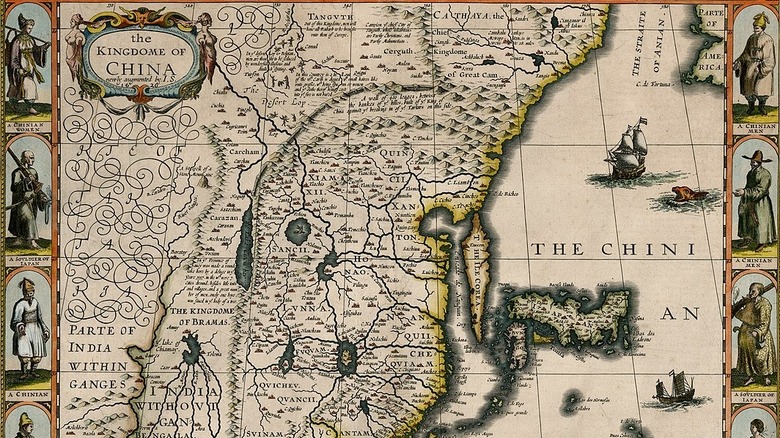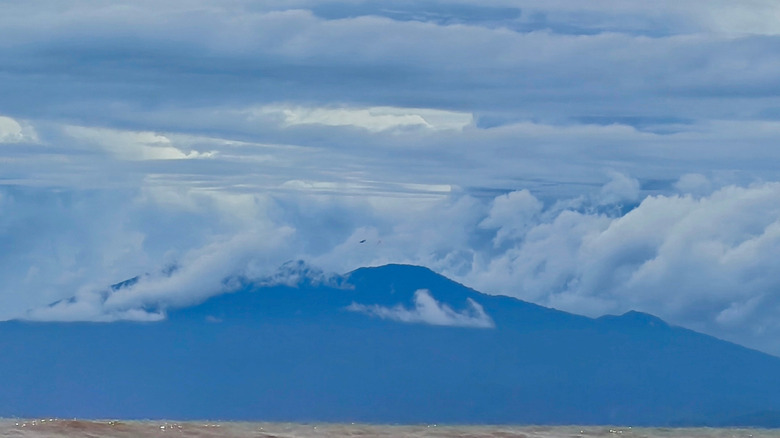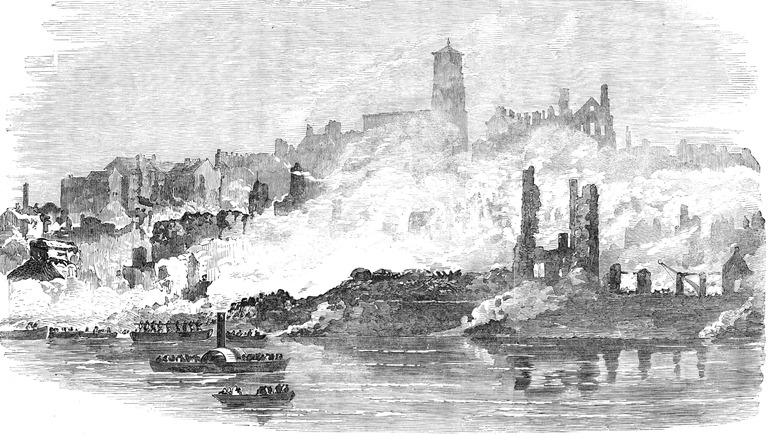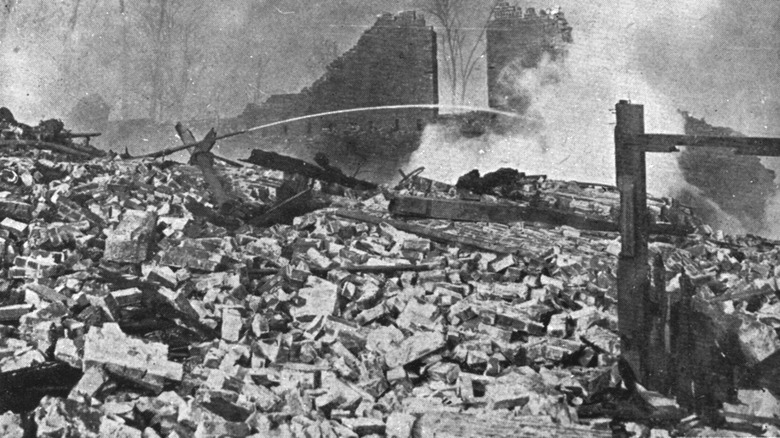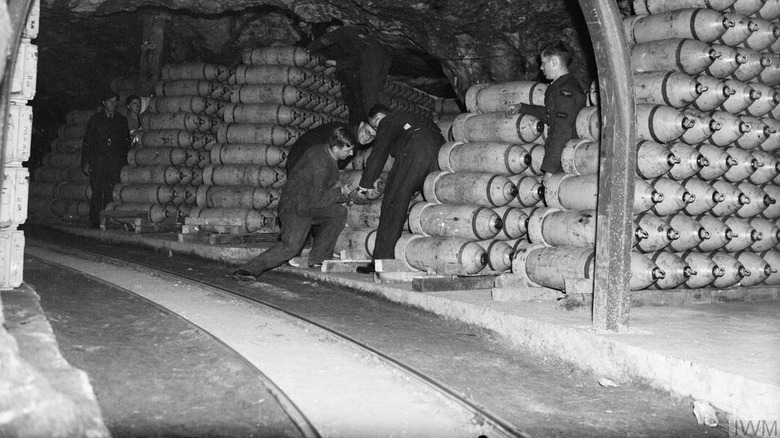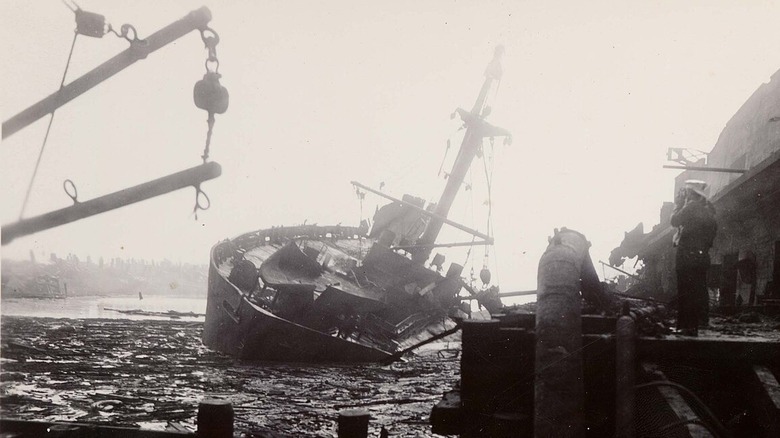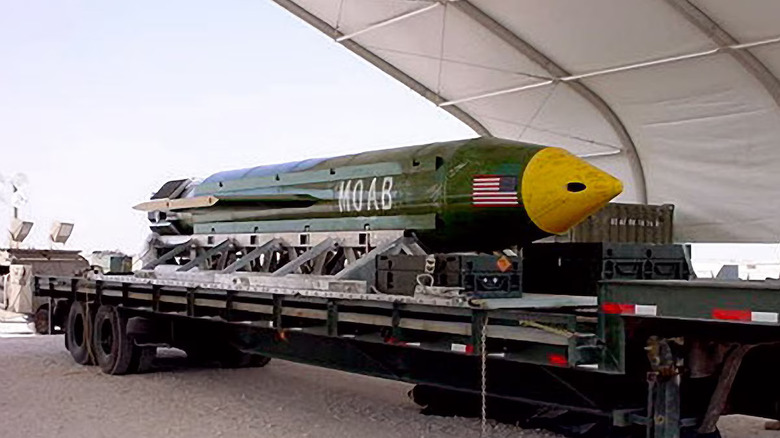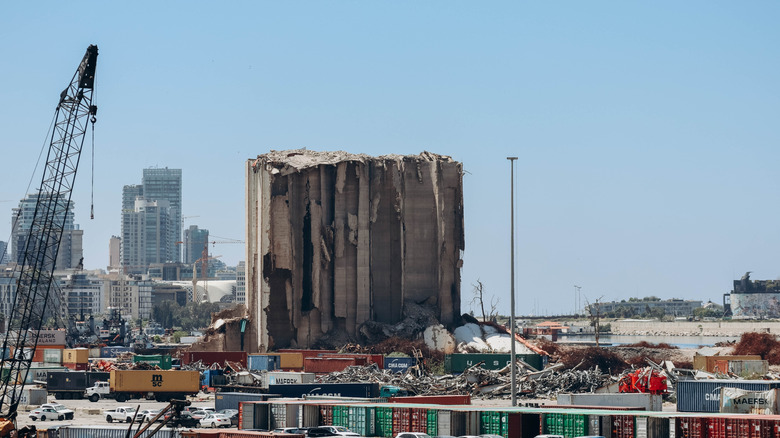The 11 Largest Non-Nuclear Explosions Ever Recorded
People have been blowing things up ever since they discovered they could. From the earliest lightning-wrought flames of forest fires to the invention of gunpowder and the advent of nuclear power, explosions have been scientifically proven to be not just incredibly cool but also helpful. Harnessing the explosive power of TNT helped America build a transcontinental railroad. The internal combustion engine and its attendant benefits arose from containing an explosion within a cylinder. Watching action stars not look back as the villain's lair goes up in flames sparks joy.
However, explosions come with some serious drawbacks. According to the U.S. Department of Energy, an explosion is a "sudden, rapid release of energy that produces potentially damaging pressures." Explosions can cause significant damage and injury, especially when they occur unexpectedly or without control. The 20th century provided an entirely new form of explosion in nuclear weapons, which have become the gold standard when it comes to destructive force. However, conventional explosions and even acts of nature still pack a serious punch when it comes to the pre-atomic concept of blowing things up.
For this list, we scoured the history books to drum up some of the most enormous non-nuclear explosions ever recorded. Some are modern, while others date back centuries. These blasts originated from various sources, ranging from volcanic eruptions and accidental detonations of volatile materials to the very deliberate dropping of ordnance.
Wanggongchang Explosion 1626
The great irony of gunpowder is that Chinese monks discovered it in search of a life-extending recipe. Little did they know that their 9th-century discovery of a particular mixture of saltpeter, sulfur, and charcoal would prematurely end far more lives than it extended. Gunpowder eventually found its way to the battlefields of Europe and beyond, resulting in vast collections of the flammable material stored in centralized locations.
The first (but not the last) entry on our list was the result of such a collection. In the 17th century, the Wanggongchang Armory, situated just west of the Forbidden City in present-day Beijing, was one of several armories in the city that produced weapons for the ruling Ming dynasty. Wanggongchong employed 70 to 80 people and operated at the direction of the Ministry of Public Works. Until it exploded.
In the mid-morning of May 30, 1626, observers noticed a plume of smoke rising from the direction of the armory. A moment later, an enormous explosion ripped through the city. In an instant, thousands of homes and businesses disappeared, along with the approximately 20,000 people within a two-square-kilometer area. A 5,000-pound stone lion leapt over the city gate. The sound of the blast reached the Great Wall of China more than 90 miles away. The event reportedly even created the mushroom-shaped cloud typically associated with nuclear explosions.
The armory had been constructed, like many armories and powder stores, with thick walls meant to direct any blasts upward. In this case, it clearly wasn't sufficient.
The Delft Thunderclap of 1649
Nearly 30 years and thousands of miles away from the Wanggchonganng Explosion, the Dutch town of Delft underwent a similar tragedy. The death knell of the city stemmed from an unexpected source — its firm military emplacements. With sturdy walls, eight gates, and two dozen or more turrets, Delft was selected as the site for the storage of precious arms and gunpowder.
Part of the honor included the construction of the Armamentarium in 1602. The Armamentarium stored masses of explosive military material, but it wasn't the only structure in the city to do so. Several other buildings in the vicinity also served the purpose, including at least five other arsenals.
At about 10:30 on the morning of October 12, 1654, Cornelius Soetens went about his regular duties, one of which included inspecting one of the Armamentarium's magazines. As the keeper of the magazine, Soetens was responsible for its safety and security. He and a guest descended into the magazine with a lit lantern. The precise sequence of events that followed remains unknown, but the magazine powder blew up shortly after.
Experts estimate that between 80,000 and 90,000 pounds of black gunpowder ignited, sparking an explosion equivalent to approximately 22.5 tons of TNT. The ultimate number of casualties is unknown, though it is undoubtedly significant. Many of Delft's citizens were out of town at a fair at The Hague or the market in Schiedam. However, a full quarter of the city was destroyed, and hundreds of buildings had to be razed in the aftermath.
Krakatoa Eruption of 1883
The next entry on our list is a testament to the overwhelming power of nature, a force that dwarfs human folly. Krakatoa Island, situated between Java and Sumatra in the Sunda Strait, is a region where the Indian-Australian and Eurasian tectonic plates converge, resulting in intense seismic and volcanic activity. This uninhabited island, essentially a colossal volcano, was poised to unleash a level of explosive violence that would redefine our understanding of natural forces.
In August 1883, evidence of seismic activity began to occur at the 6,000-foot peak of Krakatoa. That evidence became undeniable when an eruption approaching the power of 200 megatons (one megaton is equivalent to 1 million tons of TNT) burst skyward. More than 36,000 people died on the surrounding islands, making it the second-deadliest volcanic eruption in history.
Despite the appalling loss of life, the environmental impact of the eruption was nothing short of astonishing. The ash and sulfur dioxide particles it released into the atmosphere altered the very color of the sky, turning the moon a haunting shade of blue. The sound of the eruption, a pressure wave that traveled around the globe, was so loud that it was mistaken for cannon fire by witnesses up to 3,000 miles away — so far that it took hours for the report to reach them. This sound, the loudest in recorded history, was estimated to be around 310 decibels — three times the threshold at which sound becomes physically painful.
Machichaco Tragedy 1893
While conventional explosives can't muster up the same fury as Mother Nature, they can still pack a tragic wallop. The Spanish Steamer Machichaco was unloading a cargo of petroleum, wine, and flour at the Spanish port city of Santander when she caught fire. The harbor authorities responded to the burning ship to assist in fighting the fire. Unknown to the passengers, people along the quay, and firefighters, the Machicaco carried a fatal secret.
As people rushed to put out the fire, they were unaware that it was the fuse for a mighty explosion. Authorities, including the police and naval firefighters, were in the process of offloading the cargo. A towing ship was dispatched to tow the Machichaco away from the facilities. Unfortunately, the captain of the Machichago had not reported the 500 cases of dynamite in the hold, as he was obligated to do upon entering the harbor.
As the San Francisco Call plainly stated in its November 6, 1893, edition, "Hundreds of People Blown Into Fragments," and the "Air [was] filled with death." Hardly subtle, but it was the plain truth. The explosion of the Machichaco killed hundreds of responders, set fire to the city, and sank hundreds of small craft, impacting local trade and shipping.
Tunguska Event 1908
This list represents some of the most powerful explosions on Earth, but what about above it? Before nuclear weaponry and pre-dating the artillery insanity of the First World War, a cosmic air-burst projectile exploded in the sky above Eastern Siberia.
A witness who was 40 miles away described the event. "The sky split in two and fire appeared high and wide over the forest." Over 2,000 square kilometers of woodland were flattened. More than 100 square kilometers experienced charring. The energy was calculated to have been in the region of 15 megatons, or over 1,000 Hiroshima atomic bombs. The resulting dust cloud drifted to Great Britain, where it manifested as strange lights in the night sky caused by the sun's reflection.
Fortunately, that region of the planet is sparsely populated. The event entered local lore, and when a surveyor named Leonid Kulik entered the area nearly 20 years later, locals told him of the lights and where to find the damage. There is no record of a human dying, though herds of reindeer and other forest creatures were wiped out.
Perhaps the most intriguing aspect of the Tunguska Event is that the cause of the explosion remains unverified. Scientists generally agree that a meteor or asteroid fragment approximately 36 meters in diameter exploded in the atmosphere. Despite all the ground damage, there was no crater.
Halifax Explosion 1917
The Norwegian ship SS Imo, with a mission to deliver aid to Europe during the First World War, was sailing down the wrong side of the Narrows in Halifax, Canada, when it collided with the French tramp steamer Mont-Blanc. The ships had nearly avoided collision, but when the SS Imo caught the last 9 feet of the Mont-Blanc and then reversed her engines, the city's fate was sealed. The sparks caused by the separating ships started a fire.
Several ships around the port dispatched volunteers in boats to help fight the fire, which burned for about 20 minutes. Unlike the Machichaco, people were aware that munitions bound for Europe were involved. As the crews desperately tried to put out the fire, they knew they were fighting for the lives of every single person in the city. One courageous radio operator, Vincent Coleman, stayed at his post to send a final warning to the town. His final message was, "Munitions ship on fire. Making for Pier 6. Goodbye."
The Mont-Blac exploded, instantly evaporating so much water that a 60-foot-high wall of water swept in to replace it, flooding Halifax. Pieces of the Mont-Blanc were found over 3 miles from the harbor. Over 12,000 buildings in a 16-mile radius were destroyed or damaged. Over 1,500 people died instantly, and nearly 10,000 were injured. Approximately 25,000 more were left without shelter in a city with a total population of only 50,000.
RAF Fauld Explosion 1944
With a history that spans back to the inception of gunpowder, humanity has struggled to find a fail-safe method for storing and transporting munitions. The RAF Fauld explosion, a significant event that occurred thirty years after the Halifax disaster and centuries after the Delft Explosion, left an indelible mark on the history of Britain.
In 1937, England repurposed a disused gypsum mining facility to store a vast quantity of bombs. Within a few years, it was fighting for its life in the Battle of Britain. By 1944, the facility had transformed into the Royal Air Force (RAF) Fauld base. The tunnels of the old mine, each 12 feet high and 20 feet wide, housed over 24,000 tons of high explosives, along with other incendiaries and detonators.
On the fateful morning of Monday, November 27th, 1944, the RAF Fauld facility was rocked by a pair of near-simultaneous explosions of staggering magnitude. The immediate site was obliterated, and a nearby cattle farm, along with its inhabitants and livestock, vanished. The blast killed 70 people instantly. The local village of Hanbury bore the brunt, with virtually every building in town damaged or destroyed, and numerous casualties sustained.
This wasn't the only significant military accident to happen in the area. RAF Lakenheath, less than 3 hours' drive away, was the site of one of the worst military accidents involving nuclear weapons in history.
Texas City Disaster 1947
The French-registered SS Grandcamp had an innocuous cargo aboard when she sailed into Texas City in 1947. Crates, barrels, and bags of tobacco, twine, bunker oil, and fertilizer were typical goods of the day. The ranching and farming community established in the 1830s dealt in those commodities. As a deep-water port on Texas's Gulf Coast, Texas City could invite ships to load goods for export practically on its doorstep. And it was bustling — the population had more than tripled since 1940.
The problem on the morning of April 16 was the load going out — nearly 2,300 pounds of ammonium nitrate, a product commonly found in fertilizers and explosives. The crew of the ship noticed smoke in the cargo area at about 8:00 a.m., just as the city was slipping into Wednesday. The crew tried to extinguish the fire without water to avoid damaging the valuable cargo.
By 9:00 a.m., the heat in the hold had risen enough to ignite the ammonium nitrate. The explosion was heard as far as 150 miles across the flat Texas plains. A mushroom cloud rose to 2,000 feet, destroying two small planes flying overhead. Burning debris flew into the city, lighting hundreds of buildings aflame.
And then the nearby SS High Flyer exploded. The ship's enormous cargo of sulfur caught fire, and the blast instantly flattened nearby buildings and lit several industrial storage tanks of gasoline and other flammable materials alight to burn before exploding. It was the deadliest industrial accident in American history, but ammonium nitrate would strike again.
Mother of All Bombs 2017
In all this talk of poor storage and flame discipline, we've lost sight of the fact that the military makes some enormous bombs, and those things are engineered to explode. The largest conventional bomb dropped in the history of warfare did not come during World War II or from the belly of a B-52 Stratofortress over Vietnam.
President Trump cleared the military for an aggressive approach to the Islamic State in 2017. The result was that military commanders could employ larger weaponry without presidential approval, as all nuclear strikes require. Eager to destroy a cave complex that opposition fighters used for transportation, the military called up a GBU-43/B Massive Ordnance Air Blast bomb, nicknamed the "Mother of all Bombs," or MOAB, as we like to call it.
Weighing 21,600 pounds and measuring 30 feet long with a 41-inch diameter, MOAB is so big that it needs to deploy by rolling off the back of a Special Forces MC-130 variant rather than dropping conventionally. It glides to Earth under a drogue chute, equipped with a satellite navigation system to ensure precise targeting, and bursts approximately 6 feet above the ground. It's not the largest conventional bomb the United States has ever built – that honor goes to the 43,600-pound T-12 of the 1950s –– but it is the largest bomb ever dropped by the military in combat.
The military dropped MOAB in the Achin district in the Nangarhar province of Afghanistan, sending a blast wave of up to a mile in diameter as it detonated 18,000 pounds of TNT. The bomb is explicitly designed to damage and destroy underground facilities.
Beirut Explosion 2020
We're back to sloppy dock management and stored fertilizer. The city of Beirut, Lebanon, became a tragic tableau of corruption on August 4, 2020, when it became the site of the largest non-nuclear explosion in modern history. A fire began near Hangar 12 at the port of the Mediterranean city. Hangar 12 stored fireworks and barrels of kerosene in the vicinity of 2,750 tons of ammonium nitrate. You've heard that before because it's what happened to Texas City, although that event involved 2,300 pounds. This one involves over 6 million pounds.
Customs officials Nehme Brax and Joseph Skaf warned officials multiple times that a dangerous situation had developed in Hangar 12. The warnings went unheeded, and the paper trail of officials who attempted to neglect or conceal the problem caused a massive scandal in Lebanon and internationally.
When the materials finally combusted half an hour after the fire started, it was a blessing that half of the blast was directed to sea. The half that went landward penetrated the dense city by 1.2 miles. Despite Beirut's population of over two million, the number of deaths was relatively low. Over 7,000 people were injured, while 218 were killed and 300,000 displaced. Economists estimated the damage to infrastructure and trade in the billions, and the resulting investigation uncovered corruption that led to civil unrest.
Hunga Tunga Eruption 2022
Krakatoa was famous for decades for its force, but a more recent volcanic eruption exceeded it in 2022. Suppose you're wondering why you didn't feel the shockwave or hear the blast. It's because Hunga Tonga exploded underwater. A submarine volcano near the remote Kingdom of Tonga in Polynesia, Hunga Tonga, erupted on January 15, 2022, releasing an enormous amount of energy.
The explosion topped every recorded non-nuclear blast in history, made by man or nature. Some experts estimate the force to be that of five nuclear bombs, though without the radiation. Still, the University of California estimated that the explosion lasted four times longer and impacted atmospheric pressure like that of the Tsar Bomba, the largest nuclear device ever detonated.
The force of the blast was so immense that it propelled 146 megatons of water and 40 billion gallons of greenhouse gas into the atmosphere. Not just the sky, but the entire atmosphere. This eruption ultimately released approximately 100 tons of carbon dioxide, changing the Earth's climate. However, it's important to note that it also released cooling aerosols, which acted as a counterbalance to the carbon dioxide, mitigating its impact.
The ocean churned in a series of tsunamis that radiated in all directions from the epicenter. The waves caused environmental damage to nearby islands, resulting in three fatalities. However, it's worth noting that this is a remarkably low number for an event of this scale. Just imagine the potential devastation if it had occurred above ground, near a populated area.
